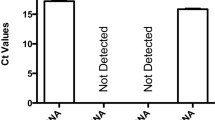Abstract
Efficient PCR amplifications require precisely designed and optimized oligonucleotide primers, components, and cycling conditions. Despite recent software development and reaction improvement, primer design can still be enhanced. The aims of this research are to understand (1) the effect on PCR efficiency and DNA yields of primer thermodynamics parameters, and (2) the incorporation of 5′ A/T-rich overhanging sequences (flaps) during primer design. Two primer sets, one optimal (ΔG = 0) and one sub-optimal (ΔG = 0.9), were designed using web interface software Primer3, BLASTn, and mFold to target a movement protein gene of Tobacco mosaic virus. The optimal primer set amplifies a product of 195 bp and supports higher PCR sensitivity and yields compared to the sub-optimal primer set, which amplifies a product of 192 bp. Greater fluorescence was obtained using optimal primers compared to that with sub-optimal primers. Primers designed with sub-optimal thermodynamics can be substantially improved by adding 5′ flaps. Results indicate that even if the performance of some primers can be improved substantially by 5′ flap addition, not all primers will be similarly improved. Optimal 5′ flap sequences are dependent on the primer sequences, and alter the primer’s T m value. The manipulation of this feature may enhance primer’s efficiency to increase the PCR sensitivity and DNA yield.







Similar content being viewed by others
References
Saiki, R., Scharf, S. J., Faloona, F., Mullis, K. B., Horn, G. T., & Erlich, H. (1985). Enzymatic amplification of beta-globin genomic sequences and restriction site analysis for diagnosis of sickle cell anemia. Science, 230, 1350–1354.
Saiki, S., Gelfand, D. H., Stoffel, S., Scharf, S. J., Higuchi, R., Horn, G. T., et al. (1988). Primer-directed enzymatic amplification of DNA with a thermostable DNA polymerase. Science, 239, 487–491.
Arif, M., Ochoa-Corona, F. M., Opit, G., Li, Z. H., Kučerová, Z., Stejskal, V., et al. (2012). PCR and isothermal-based molecular identification of the stored-product psocid pest Lepinotus reticulatus (Psocoptera: Trogiidae). Journal of Stored Product Research, 49, 184–188.
Kim, J. S., Lee, G. G., Kim, J., Kwon, J. Y., & Kwon, S. T. (2008). The development of rapid real-time PCR detection system for Vibrio parahaemolyticus in raw oyster. Letters in Applied Microbiology, 46, 649–654.
Peng, X. H., Cao, Z. H., Xia, J. T., Carlson, G. W., Lewis, M. M., Wood, W. C., et al. (2005). Real-time detection of gene expression in cancer cells using molecular beacon imaging: New strategies for cancer research. Cancer Research, 65, 1909–1917.
Mann, T., Humbert, R., Dorschner, M., Stamatoyannopoulos, J., & Noble, W. S. (2009). A thermodynamic approach to PCR primer design. Nucleic Acids Research, 37, e95.
Lowe, T., Sharefkin, J., Yang, S. Q., & Dieffenbach, C. W. (1990). A computer program for selection of oligonucleotide primers for polymerase chain reactions. Nucleic Acids Research, 18, 1757–1761.
Doty, P., Boedtker, H., Fresco, J. R., Haselkorn, R., & Litt, M. (1959). Secondary structure in ribonucleic acids. Proceedings of the National Academy of Sciences of the United States of America, 45, 482–499.
Fresco, J. R., Alberts, B. M., & Doty, P. (1960). Some molecular details of the secondary structure of ribonucleic acid. Nature, 188, 98–101.
Manthey, A. M. (2005). mFold, delta G, and melting temperature: What does it mean. http://cdn.idtdna.com/Support/Technical/TechnicalBulletinPDF/mFold_Delta_G_and_melting_temperature_explained.pdf.
Zuker, M. (2003). mFold web server for nucleic acid folding and hybridization prediction. Nucleic Acids Research, 31, 3406–3415.
Wei, T., & Clover, G. (2008). Use of primers with 5′ non-complementary sequences in RT-PCR for the detection of nepovirus sub groups A and B. Journal of Virological Methods, 153, 16–21.
Afonina, I., Ankoudinova, I., Mills, A., Lokhov, S., Huynh, P., & Mahoney, W. (2007). Primers with 5′ flaps improve real-time PCR. BioTechniques, 43, 770–772.
Binladen, J., Gilbert, M. T., Campos, P. F., & Willerslev, E. (2007). 5′ Tailed sequencing primers improve sequencing quality of PCR products. BioTechniques, 42, 174–176.
Mackenzie, A. M., Nolan, M., Wei, K. J., Clements, M. A., Gowanlock, D., Wallace, B. J., et al. (1998). Ceratobium mosaic potyirus; another virus from orchids. Archives of Virology, 143, 1–12.
Rozen, S., & Skaletsky, H. J. (2000). Primer3 on the www for general users and for biologist programmers. In S. Krawetz & S. Misener (Eds.), Bioinformatics methods and protocols: Methods in molecular biology (pp. 365–386). Totowa, NJ: Humana Press.
Altschul, S. F., Gish, W., Miller, W., Myers, E. W., & Lipman, D. J. (1990). Basic local alignment search tool. Journal of Molecular Biology, 215, 403–410.
McDaniel, L., Maratos, M., & Farabaugh, J. (1998). Infection of plants by Tobacco mosaic virus. The American Biology Teacher, 60, 434–439.
Ochoa Corona, F. M., Tang, J., Lebas, B. S. M., & Alexander, B. (2007). Validation of primer design for plant virus diagnostics using the web-interface pathway Primer3–mFOLD–BLASTn. Phytopathology, 97, S86.
Goelet, P., Lomonossoff, G. P., Butler, P. J., Akam, M. E., Gait, M. J., & Karn, J. (1982). Nucleotide sequence of Tobacco mosaic virus RNA. Proceedings of the National Academy of Sciences of the United States of America, 79, 5818–5822.
Arif, M., Garzon, C. D., & Ochoa-Corona, F. M. (2011). Detection and discrimination of Pythium aphanidermatum and P. deliense by single probe based real time PCR and multiplex end point PCR. Phytopathology, 101, S9.
Acknowledgments
We thank Jacqueline Fletcher, Ulrich Melcher, Astri Wayadande, and Shefali Dobhal for reviewing this manuscript. This study was funded by the Oklahoma Agricultural Experiment Station (Project Numbers OKL02773). The mention of trade names or commercial products in this publication does not imply recommendation or endorsement by Oklahoma State University.
Author information
Authors and Affiliations
Corresponding author
Rights and permissions
About this article
Cite this article
Arif, M., Ochoa-Corona, F.M. Comparative Assessment of 5′ A/T-Rich Overhang Sequences with Optimal and Sub-optimal Primers to Increase PCR Yields and Sensitivity. Mol Biotechnol 55, 17–26 (2013). https://doi.org/10.1007/s12033-012-9617-5
Published:
Issue Date:
DOI: https://doi.org/10.1007/s12033-012-9617-5




